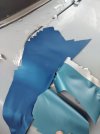Let's clear this up.
Ceramic coatings are all different, some no better than wax or as good, and then the real ones where, when done professionally, will cost you upwards of 1500 to 2000 dollars.
With us getting a lot of new customers from the majors, I'm getting flack about the temps I give for epoxy, neutralizing acid, and warning on ceramic coatings. The majors dont try to educate people except on their product, right, wrong, or stupid; I do.
Here is my experience with ceramic coatings; a factory paint job is 4 to 5 mils on average. I have never seen a problem or heard of one.
I have had a handful of calls from insurance jobs at the most, where they did bubble as usually very little paint is applied, and it's across the board as far as the board of brands of clear and paint used.
I've had more from restoration jobs in the past than I cant guess but think about the number of mils and how many months they take to cure fully.
So if you want to think ceramic is an issue with only SPI products, then use another paint brand.
Restorations are the most significant concern because we have a lot of mils of material, and these cars are not exposed to the sun for final curing.
Using the high-end ceramic, does that mean there will be a failure? No, but sure can, and is it worth the risk to redo for free?
But the chance that is why we warn you as paint must breathe.
Use at your own risk.
Ceramic coatings are all different, some no better than wax or as good, and then the real ones where, when done professionally, will cost you upwards of 1500 to 2000 dollars.
With us getting a lot of new customers from the majors, I'm getting flack about the temps I give for epoxy, neutralizing acid, and warning on ceramic coatings. The majors dont try to educate people except on their product, right, wrong, or stupid; I do.
Here is my experience with ceramic coatings; a factory paint job is 4 to 5 mils on average. I have never seen a problem or heard of one.
I have had a handful of calls from insurance jobs at the most, where they did bubble as usually very little paint is applied, and it's across the board as far as the board of brands of clear and paint used.
I've had more from restoration jobs in the past than I cant guess but think about the number of mils and how many months they take to cure fully.
So if you want to think ceramic is an issue with only SPI products, then use another paint brand.
Restorations are the most significant concern because we have a lot of mils of material, and these cars are not exposed to the sun for final curing.
Using the high-end ceramic, does that mean there will be a failure? No, but sure can, and is it worth the risk to redo for free?
But the chance that is why we warn you as paint must breathe.
Use at your own risk.
Last edited:

